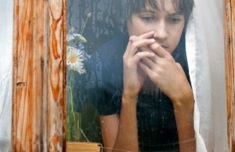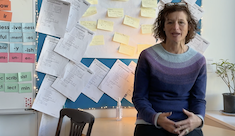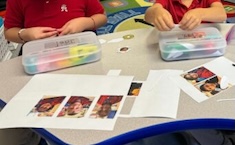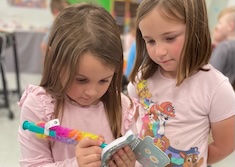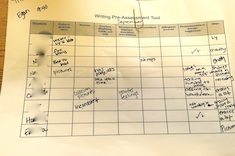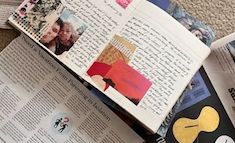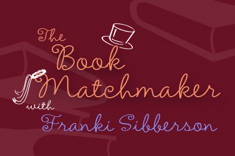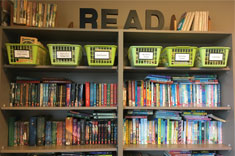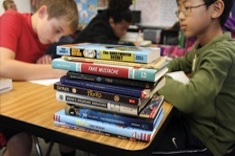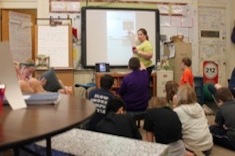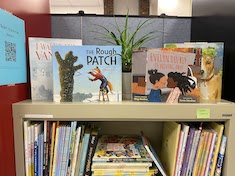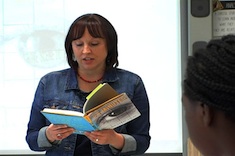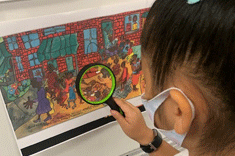Library
Choice Literacy Articles & Videos
The Choice Literacy library contains over 3,000 articles and 900 videos from 150+ contributors. Classic Classroom and Literacy Leadership subscribers have access to the entire library. Content is updated continuously, with five to six new features published each week.
Latest Content
Photo Booth and Young Readers
Stella Villalba uses the Photo Booth app to build stamina in a young English language learner, as well as reinforce the learning and practice at home.
Jose the Late Bloomer
Stella Villalba has practical advice for reaching a young English language learner who is reluctant to write and often frustrated.
Reading Nonfiction: A Paper Anchor Chart
Tammy Mulligan explains her process of using multiple versions of an anchor chart to help students remember and personalize a process for reading nonfiction texts.
Using Me Boxes to Promote Identity, Academics, and Play
Tara Barnett and Kate Mills share a powerful (and simple) community activity. Students create their own Me Boxes to use (and update) throughout the school year to promote identity, academics, and play. Me Boxes originated from thinking about developmentally appropriate ways to build in work around identity in the classroom, as taught to us by Gholdy Muhammad in her book Cultivating Genius.
Play Is Powerful: Sharing Student Learning with Families
When kindergarten teacher Becca Burk overheard students’ parents comparing herself and a colleague, she reflected on the importance of play for young learners. In this article, Becca shares ways to communicate the power of play and students’ learning with families.
Administering a Pre-Assessment
Melanie Meehan works with a new teacher to develop and administer a writing pre-assessment early in the school year.
Writing as an Act of Resistance and a Source of Strength
In this beautiful personal essay, Stella Villalba reminds us that writing is a source of strength, and developing a community of writers is essential in post-pandemic classrooms.
Book Matchmaker: Read Alouds That Invite Young Readers to Participate
Franki Sibberson shares her latest suggestions for read alouds that invite participation from young readers.
Launching a Classroom Library
Melissa Styger slows down the launch of the classroom library to ensure it is a valuable resource all year.
Field Experience: Supporting Independent Reading, Choice and Stamina
Helping students learn to choose books and develop stamina are important to developing independent readers. Ruth Ayres designed a field experience with opportunities to see minilessons, small group instruction, team meetings and a share session that support independence in readers.
Using 9/11 Research to Build Community and Writing Process
Katherine Sokolowski gives space for students to research and share their learning about 9/11 in order to build a community of writers, as well as nourish the research and writing process.
Building Community Access to Texts Through a Lending Library
Tara Barnett and Kate Mills share the way a lending library can provide an additional resource for teachers and community members to quickly get the books they need. They offer practical steps to make the lending library a go-to resource as well as a template to track the monthly book highlights.
Trusting the Letting-Go Moments
Mandy Robek writes a powerful essay about giving her students more decision-making power in sharing their learning. In the release of letting go, she found ease in the joy of learning.
Kindergarten: Conferring with Grace
Hayley Whitaker confers with Grace about her writing early in the year.
The Sharpening Stone
Summer is rushing along. Are you feeling restored or refreshed yet for the new year? Suzy Kaback writes about the power of the sharpening stone.
Strategic Seating
Mark Levine finds that good seating design in middle school isn’t just about where you place furniture—it’s about negotiating with students.
Goals and How-to Writing in First Grade
Danielle French helps a first grader set nonfiction writing goals.
Nonfiction Books for Compassion, Inspiration, and Heart
Mandy Robek set out on a quest to discover new nonfiction books with characters who offer inspiration, compassion, and heart. Here are eight new titles you won’t want to miss.
Books That Sustain the Linguistic Lives of Multilingual Learners
We need more bilingual books! Stella Villalba explains why these books are essential and provides a booklist to help sustain the linguistic lives of multilingual learners.
Middle-Grade Mental Health Booklist
Leigh Anne Eck shares an important booklist for middle-grade readers on mental health topics and with characters navigating mental health struggles.
Talking Through Characters
Melanie Meehan shares activities that help students talk about their characters before writing about them in a realistic fiction unit.
Moving from Whole-Class Texts to Independent Reading: Characterization
Gretchen Schroeder offers a starting point to help her high school students prepare to write an in-depth character analysis essay.
The Shades of Sadness: Character Feelings and Traits
Melissa Quimby is disappointed with the way her students expressed depth of character traits and feelings. By building on their strengths, Melissa creates a tool for students to use and adapt as they learn to be more specific and intentional about describing characters.
Choice Literacy Writing Guidelines
Are you interested in writing for Choice Literacy? Here are our guidelines.
Personal Touches Early in the Year – Classroom Design Photo Essay Series
Make it personal with these lovely design suggestions from "The Sisters" for bringing students' homes into your classroom.
I Think, I Wonder, I Understand: Making Sense of the Work of Literacy Coaches
Jan Miller Burkins works with colleagues to develop the “I Think I Wonder I Understand” reflective tool for literacy coaches.
Unlocking Student Thinking: The Power of Problem Posing in Story Problem Contexts
Choice Numeracy | Problem posing is a strategy that involves students creating mathematical problems to solve or reworking given problems to change them in some way. Mallory Messenger shows how this strategy allows students to explore and test their current thinking. Download the Problem Posing with Problem Stems Recording Sheet to get started in your classroom.
Book Matchmaker: 3rd Graders Reading Below Grade Level
In this installment of Book Matchmaker, Franki Sibberson shares her favorite books for 3rd graders who are not at grade level, but don’t want to read texts that will embarrass them in front of their peers.
Picture Books for Naming Emotions
Mandy Robek continues her series on picture books for understanding emotional turmoil in students. In this installment, she shares a list of books that can help children name emotions.
Browse Content By
Type
Category
- Assessment Tools
- Big Fresh Archives
- Booklists
- Choice Numeracy
- Classroom Design
- Common Core
- Community Building
- Conferring
- Content Literacy
- Digital Literacy
- English Language Learners
- Equity
- Family Relations
- Free Samples
- Guiding Groups
- Leadership
- Literacy Coaches
- Mentor Texts
- Minilessons
- New Teacher Mentors
- Podcasts
- Poetry
- Quote Collections
- Reading Strategies
- Self Care
- Struggling and Striving Learners
- Talking and Listening
- Teacher Study Groups
- Teaching Reading
- Teaching Writing
- Word Study and Vocabulary
Author
- Melissa Quimby
- Nawal Qarooni
- Gwen Blumberg
- Julie Cox
- The Lead Learners
- Hannah Tills
- Josie Stewart
- Ruth Metcalfe
- Mallory Messenger
- Becca Burk
- Jodie Bailey
- Vivian Chen
- Mary Brower
- Tiffany Abbott Fuller
- Stephanie Affinito
- Ruth Ayres
- Leigh Anne Eck
- Heather Fisher
- Shari Frost
- Julie Johnson
- Suzy Kaback
- Gigi McAllister
- Shirl McPhillips
- Melanie Meehan
- Cathy Mere
- Debbie Miller
- Tara Barnett and Kate Mills
- Tammy Mulligan
- Dana Murphy
- Bitsy Parks
- David Pittman
- Brenda Power
- Heather Rader
- Matt Renwick
- Mandy Robek
- Christy Rush-Levine
- Gretchen Schroeder
- Jen Schwanke
- Brian Sepe
- Katherine Sokolowski
- Stella Villalba
- Jennifer Vincent
Grade Level
Choice Literacy Membership
Articles
Get full access to all Choice Literacy article content
Videos
Get full access to all Choice Literacy video content
Courses
Access Choice Literacy course curriculum and training


